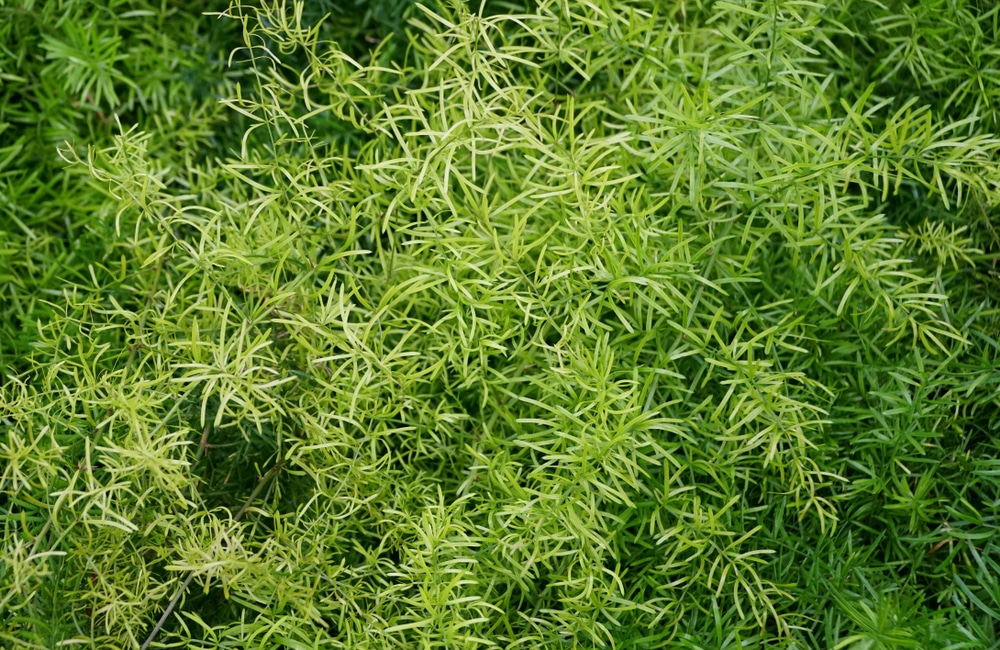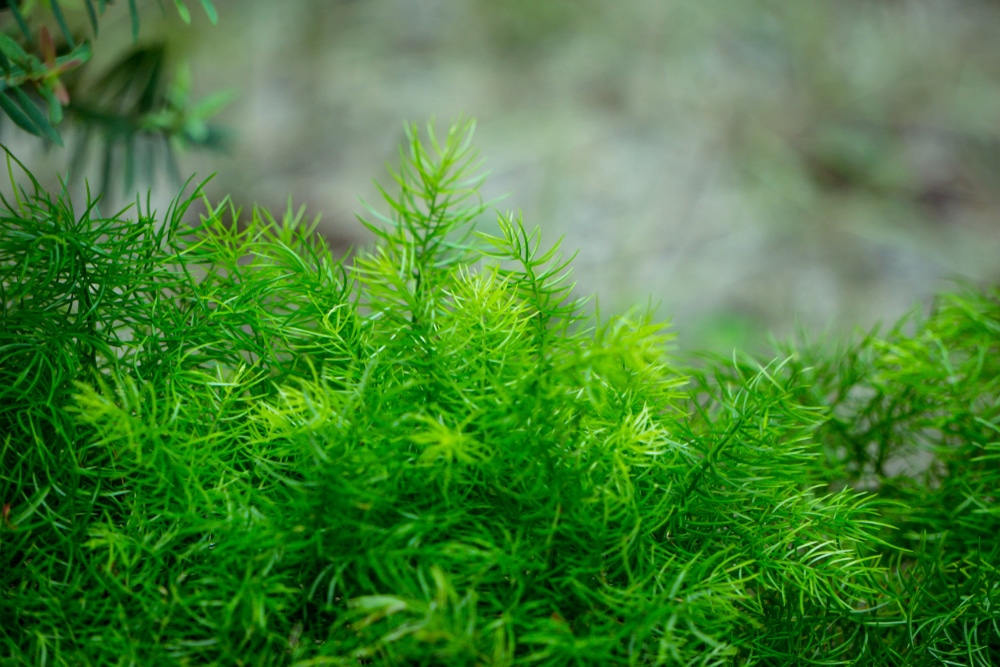Though it is commonly called asparagus fern, this plant is not a fern at all. It is a member of the lily family, and shares many characteristics with other members of that family.
Asparagus ferns have arching stems with short, needle-like leaflets. The asparagus fern’s delicate leaves complement other house plants, and its feathery foliage is perfect for hanging baskets and multi-level plant stands.

| Botanical Name | Asparagus densiflorus ‘Sprengeri’ |
| Common Name | Sprengeri Asparagus Fern, Asparagus fern, Sprengeri Fern |
| Plant Type | Herbaceous perennial |
| Flower Color | Small light pink or white flowers |
| Size When Mature | 12-30 in. Up to 36 inches tall, 48 inches wide, 12-24 in. wide |
| Bloom Time | Spring to fall |
| Sun Requirements | Outdoor: Partial sun; Indoors: bright, indirect light |
| USDA Hardiness Zones | 9-11 |
| Soil PH Range | 6.5-6.8 |
| Soil Type | Well-draining, slightly acidic soil |
| Water Needs | Moderate Water |
| Native Area | South Africa |
What You Need to Know About Sprengeri Fern
Asparagus ferns are a fast-growing, herbaceous perennial that is often used as a decorative accent in gardens or potted plants. They are native to Africa, but have been introduced to many other parts of the world.
Asparagus ferns have an extensive root system that is composed of a mass of fine roots and tubers. The bushy, foxtail-like stems gracefully arch backwards and are covered in small, sharp needles.
The white or light pink blooms are tiny, barely noticeable and partly hidden by leaves. They have a delicate scent and bloom once every few years. The round fruits are bright red, glossy berries with one black seed inside.
Although they may look harmless, asparagus ferns can be toxic to both humans and animals. The sap of the plant contains chemicals that can cause skin irritation, and if ingested, asparagus ferns can cause vomiting and diarrhea in both humans and pets. As such, it is important to exercise caution when handling these plants. While asparagus ferns are not necessarily dangerous, they can cause discomfort if mishandled. Therefore, it is best to admire them from a distance and keep them out of reach of children and pets.
Asparagus ferns grow well in a variety of habitats, including woodland edges, common gardens, and even roadside ditches. In some areas, they have become invasive due to their rapid growth and ability to spread easily. If planted in the ground, asparagus ferns can quickly take over an area, crowding out native plants. They can also form dense mats that smother other vegetation. As a result, it is important to be careful when planting asparagus ferns. In many cases, they are best suited for container gardening where they can be controlled more easily.
How to Care for Sprengeri Fern
Here’s everything you need to know about growing and caring for a thriving Shamrock Plant.
Light
As anyone who has ever tried to grow a plant knows, light is essential for plant growth. However, not all plants need the same type of light in order to thrive.
The Sprengeri fern is a type of plant that does best in bright, indirect light. This means that it should be placed near a window where it will receive plenty of light, but not direct sunlight. It is also important to give the plant a quarter turn every week or so in order to encourage even growth. If you do not have a window available, this fern can also be grown under artificial light.
However, it is important to set the plant 8 to 12 inches below the light source in order to prevent it from getting too much light. For best results, artificial light should be provided for 14 to 16 hours per day.
Water and Soil Needs
Watering your sprengeri fern on a regular basis is critical for the plant’s long-term health. The soil should be moist but not soggy, and the plant can endure brief periods of drought. Water requirements are reduced in the winter.
If you notice that the leaves are starting to turn brown, you may need to increase the amount of water you are giving the plant. Brown leaves can also be a sign that the plant is not getting enough light.
Daily misting of the leaves is also beneficial, as it will increase the humidity around the plant and prevent the leaves from drying out.
Sprengeri ferns prefer well-draining, slightly acidic soil. If you are growing your fern indoors, a potting mix specifically for ferns is ideal. If you are growing your fern outdoors, it is a good idea to mix some sand or perlite into the soil to improve drainage.
Temperature Requirements
The sprengeri fern is a beautiful, low-maintenance plant that can thrive in a variety of indoor environments. Though it prefers an average room temperature of 65-75°F, it can tolerate 50°F. The sprengeri fern does not require special care, as long as it is not allowed to dry out. Keep this plant away from heat and air conditioning vents that might cause it to lose moisture.
Fertilizer
While many people focus on the decorative aspect of houseplants, it is important to remember that they are living creatures that require regular care in order to prosper. One important aspect of plant care is feeding. Sprengeri ferns may need to be fertilized on a weekly basis during the summer months. When applying fertilizer, it is important to diluted it by half in order to avoid damaging the plant. Monthly feedings are sufficient during spring through fall.
Common Diseases
Despite its hardy nature, the sprengeri fern is not immune to disease and pests. Some of the most common problems include root rot, mealybugs, and spider mites.
Sprengeri Fern Propagation
One of the best things about sprengeri ferns is that they are very easy to propagate. Stem cuttings will not work. However, rhizome division is very successful. This can be done by carefully digging up the plant and dividing the roots into smaller sections. Each section should have at least two leaves. The root sections can then be replanted in new pots filled with fresh potting mix.

